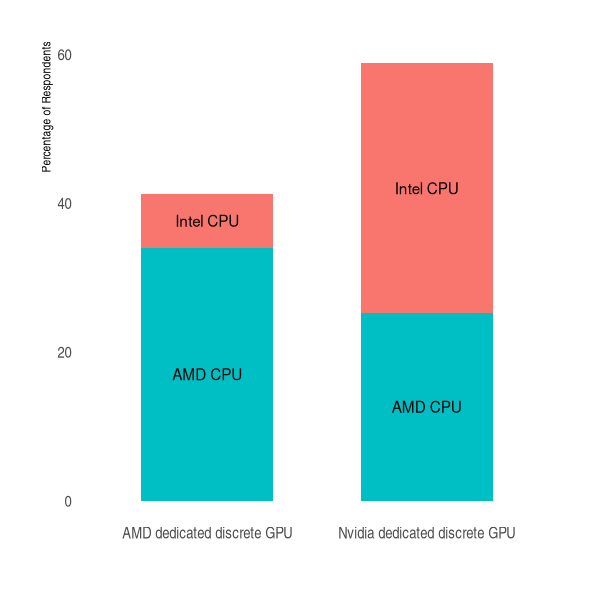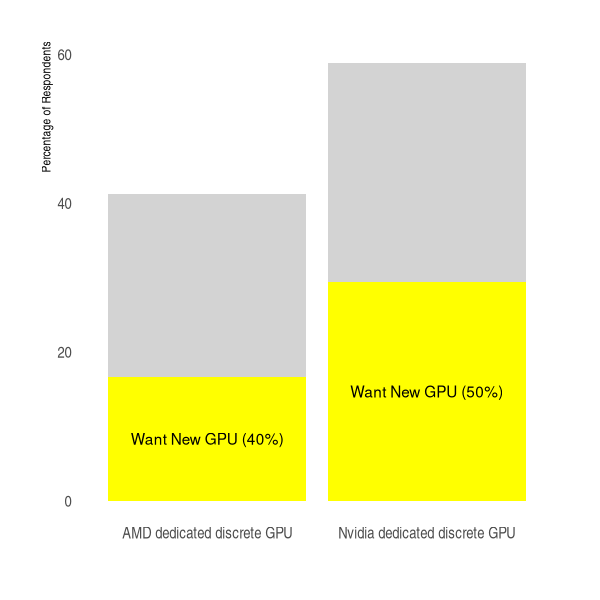AMD on the Brink of Taking Over - Survey Q2 2021
After our recent analysis from the Q2 2021 survey covering the evolution and future of Cloud Gaming, we wanted to focus on a topic we had already touched upon before. We had previously seen in the ProtonDB data that AMD was seriously taking over the gaming scene on Linux both in terms of CPU and GPU penetration. The recent survey enables us to confirm if this is indeed the case, and also confirm what are the key drivers for the market changes. So, what did we actually see this time around?
Important Note: the following results focus on respondents who use a machine with a discrete GPU card. Users with APUs or integrated graphics solutions are filtered out.
GPU and CPU Relationship
First let’s have a look at the following breakdown - the left bar represents the percentage of users with an AMD GPU, and the right bar the ones using Nvidia. We also break down the inside of each bar with CPU brand usage.

From this chart we can make the following observations:
- Nvidia GPU configurations are still the majority (close to 60%)
- AMD CPU + AMD GPU configurations are REALLY a thing. There’s very few people who use Intel CPUs and AMD GPUs together.
- Most Nvidia GPU owners are still on an Intel CPU
Note that all of these observations are very consistent with what we observed using the ProtonDB data just a few months ago. Which is great, because this confirms that the sample found in ProtonDB may be quite representative after all.
Who Wants a New Shiny GPU?
There’s a good chunk of people across the board who want a new GPU. This is true both for current Nvidia and AMD GPU owners, while there seems to be a slightly higher percentage among Nvidia users (the grey zone indicates users who did not signal any intent to renew their GPU in the near future):

This is probably linked with the shortages experienced since the COVID-19 pandemic started, making it very difficult for more than a year to purchase new GPUs at decent prices. Overall, almost 50% of respondents would be interested to change their existing GPU!
A new GPU, sure! But which Brand?
For those who are interested in a new GPU, we did ask the question as to which brand would be their favorite going forward. This is where things get really interesting (relative percentages less than 10% are not labelled).

What we can understand from this:
- AMD GPU users are not even thinking about Nvidia (about 90% would stay with AMD) - which probably means they are very happy with the choice they have made so far.
- Nvidia GPU users are leaning very fast to AMD for their next GPU (about 60% of them), which means there is a good chunk of current Nvidia owners who are not fully satisfied or convinced by Nvidia’s direction.
Why Prefer one Brand over Another?
If you would like to see the main reasons driving Nvidia users to AMD, or Nvidia users staying with Nvidia for their next GPU, the following graph will give you some perspective (this is based on respondents who want to change their current GPU card whenever possible):

As you can see, gamers moving to AMD are driven by philosophical (i.e. FOSS) and practical reasons for the most part, while gamers staying on Nvidia stay for specific features and better performance.
To give additional perspective, we picked up some of the free text comments from Nvidia users intending to move to AMD below. Quotes have been slightly modified to correct spelling and grammar:
I am using Nvidia right now. It’s not open-source but it still works better then AMD’s drivers. But I would like to buy, and I’m going to because they open their source code. I’m just waiting for the perfect driver and new card (mine is brand new :))
Currently I have a RTX 2080, but I’m thinking about buying AMD, because of the open-source drivers, better Linux compatibility, and better performance in some games. Also from I what I know AMD drivers support Wayland.
I want to switch to Wayland. If Nvidia steps up their game, I might stay with Nvidia.
AMD’s drivers fix some of the bugs I have with Nvidia and KDE.
Open-source drivers, better performance, lower CPU overhead
Now for Nvidia users who plan to stick with Nvidia (while this is a minority), here are some of the comments we could find as well (quotes again have been slightly modified here for easier reading and clarification):
Although AMD cards might be paired in raw performance, at most price points Nvidia cards are way richer feature-wise (DLSS for example). I also work as a data scientist and sometimes work/test things in my machine so CUDA is really important for me for Deep learning applications.
- I have a G-Sync only monitor (no FreeSync) 2) I use Proton a lot and, if you check the issues on the tracker or ProtonDB, you’ll see that most issues with Proton are on AMD, with the relevant exception of CP2077 3) The best GPU for pure performance is still Nvidia
Long time ago I struggled with Radeon drivers, then tried Nvidia and it was well supported. Stayed with Nvidia since
DLSS, better RT, stronger computation
Nvidia has still the best performance cards. As much as I like AMD, ideologically they are not there yet.
Machine learning due to better CUDA support. Plus power at the cost of premium :)
Blender performance, optix, DLSS
Noise to performance. AMD of course wins in sticking to the having any open-source whatsoever category, but I need the quietest components, and want to sacrifice as little performance as possible.
Ray-tracing!
NVIDIA is becoming more open-source friendly, and with CoolBits and X Server Settings I get good performace. I can keep my GPU from making other components warm/hot by having the GPU fan run at 15%. Also, I tried an AMD GPU and couldn’t get the NVIDIA driver removed, which caused my CPU to run under high load.
NVENC and CUDA.
While there were very few people who intend to move away from AMD to go to Nvidia, their reasons were typically as follows:
Gaming and Blender performance
Ray-tracing is great. Also, the price of 30XX cards are great when compared to the price of AMD cards
Hardware-encoding capabilities
We can kind of split the arguments mostly in two categories:
- Reasons to switch to AMD: open-source drivers through Mesa, Wayland support, and potentially better performance
- Reasons to stay with Nvidia: CUDA, Ray-tracing, G-Sync, DLSS, excellent driver yet proprietary, NVenc and perceived performance (somewhat debatable)
Even though I am using Nvidia myself, I don’t really have a strong opinion either way - both sides have good arguments, and if you mostly care about gaming AMD has become a very good choice. Nvidia still wins by having more proprietary features, and is essential for anyone working with Machine Learning these days because of CUDA support.
There were rumors of a big GPU vendor opening up their drivers. If this happens to be Nvidia, this could change the landscape of AMD vs. Nvidia since more AMD supporters point out to open-source drivers as being a key reason for their move. Even if Nvidia moves to become more open-source friendly, how and how far they take such efforts would be to consider (what would they actually open? Would things like CUDA remain closed source?). Nvidia would have a uphill battle to convince that such efforts are genuine, so it might take time to make a difference.
If nothing changes anytime soon when the market for GPUs becomes more favorable, we could expect AMD to continue gaining share among Linux gamers, both for CPU and GPU choices. If we are to believe the intention described by respondents here, we could very well see AMD taking over the lead in terms of GPU share within a year or two vs Nvidia, among Linux gamers: 40/60 share with about ⅓ of Nvidia users thinking about switching to AMD, the gap could close very fast.
Nvidia is, however, a very different beast than Intel; they are still at the frontline of innovation when it comes to GPUs - they were the first to foray into RayTracing and DLSS. They are also typically leading the very high end of the performance game, and not just on the Linux side of things. Still, AMD is in better shape than they have ever been, and definitely going into uncharted territory!
If you’d like to stay on top of all the upcoming articles related to the Q2 2021 Linux Gamers Survey results, consider subscribing to our newsletter:
[newsletter_form form=“1”]
